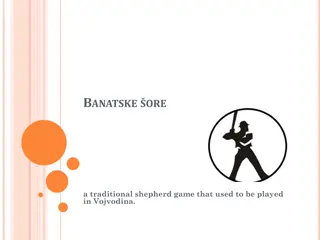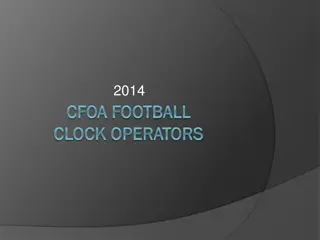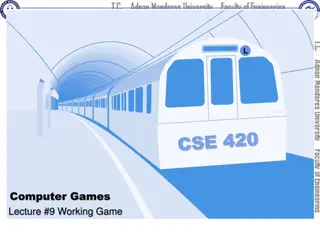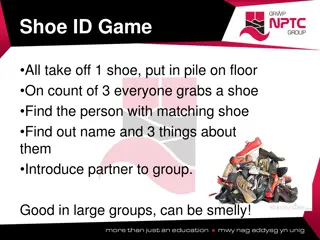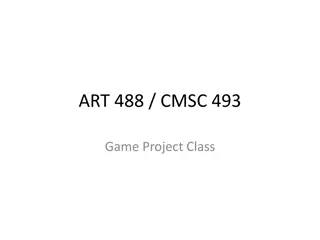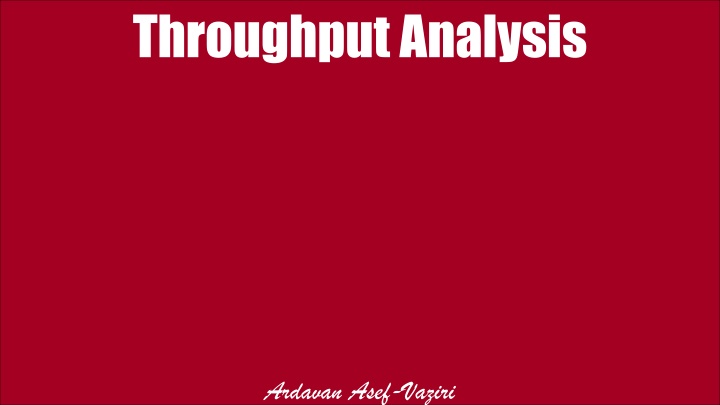
Throughput Analysis and Resource Management in Operations
Explore the application of Throughput Analysis in optimizing resource utilization and flow times in operations management. Dive into scenarios, calculations, and implications to enhance efficiency.
Uploaded on | 1 Views
Download Presentation

Please find below an Image/Link to download the presentation.
The content on the website is provided AS IS for your information and personal use only. It may not be sold, licensed, or shared on other websites without obtaining consent from the author. If you encounter any issues during the download, it is possible that the publisher has removed the file from their server.
You are allowed to download the files provided on this website for personal or commercial use, subject to the condition that they are used lawfully. All files are the property of their respective owners.
The content on the website is provided AS IS for your information and personal use only. It may not be sold, licensed, or shared on other websites without obtaining consent from the author.
E N D
Presentation Transcript
Throughput Analysis Ardavan Asef-Vaziri
The Situation Tp=4 hrs Rp1=0.75/hr Rp1=6/day c=3 Tp=3 hrs Rp1=0.667/hr Rp1=8/day c=2 Tp=2.4 Rp1=0.833/hr Rp1=10/day c=2 Throughput Analysis Basica-2, A. Asef-Vaziri, Systems & Operations Management. 2
Utilization, Inventory, Flow Time, Littles Law a) Suppose throughput is 12 contracts per day. Compute the average number of jobs on all machines. Station Station1 Station2 Station3 Ip = 1.5+2+1.2 = 4.7 Rp 16 18 20 R 12 12 12 U 0.75 0.667 3 .6 c 2 Ip 2* 0.75 = 1.5 3* 0.667 = 2 2*0.6 = 1.2 2 Using the Little s Law Theoretical Flow Time = 3+4+2.4= 9.4 hrs ex: 3 = 24hrs (1/8) [8 is capacity of station 1] RT=I 12(9.4/24) = I I = 4.7 Throughput Analysis Basica-2, A. Asef-Vaziri, Systems & Operations Management. 3
Utilization, Inventory, Flow Time, Littles Law b) Suppose Max-WIP in the game is set to 20, and average WIP is 18. That means on average there are 18 either in the waiting lines or on the machines. Compute the Flow Time ? RT=I 12T= 18 T = 1.5 days How long a job spends in the waiting lines T=1.5(24) = 36 hrs T=Tp+Ti 36=9.4+Ti Ti= 26.6 hrs Compute the ratio of the time in waiting lines to the time on the machines Ti/Tp= 26.6/9.4= 2.83 Throughput Analysis Basica-2, A. Asef-Vaziri, Systems & Operations Management. 4
Implied Utilization c) Can this system handle 19 contracts per day? The system cannot even handle 16 orders per day because when utilization get close to 100%, flow time increases exponentially. At 16 contracts per day, U1=1, U2=0.89, U3=0.8. Utilization of Station-2 also is a sign of warning. To handle 19 contracts per day, since capacity of the system is 16 contracts per day. Implied Utilization =19/16 = 1.1875 d) If the firm wishes to process all the contracts, how many machines of each type are needed? # of Station-1 machines required = 19/8 = 2.375 # of Station-2 machines required = 19/6 = 3.167 # of Station-3 machines required = 19/10 = 1.9 Throughput Analysis Basica-2, A. Asef-Vaziri, Systems & Operations Management. 5
Resources We need 2.375, 3.167, and 1.9 resource units. Indeed 3, 4, and 2. We have 2, 3, and 2. We may buy one machine for each of the three stations. In that case, utilization of the three stations are as follows. Rp1 8 6 10 c 3 4 2 Rp 24 24 20 R 19 19 19 U S1 S2 S3 0.79167 0.79167 0.95 The utilization of station 3 is scary. High utilization, in presence of variability, leads to long waiting lines. Throughput Analysis Basica-2, A. Asef-Vaziri, Systems & Operations Management. 6
Resources We need 2.375, 3.167, and 1.9 resource units. Indeed 3, 4, and 2. We have 2, 3, and 2. We may buy one machine for each of the three stations. In that case, utilization of the three stations are as follows. Rp1 8 6 10 c 3 4 2 Rp 24 24 20 R 19 19 19 U S1 S2 S3 0.79167 0.79167 0.95 For example: A paralegal who works 8hrs/ day will need to work overtime of 0.25hrs. 0.25(8) = 2 hours total over time. There will be 6 paralegals; over time of each = 2hrs/6 = 1/3 hour Or 20 minute per paralegal. PLUS some safety Capacity. Or we may use tax lawyers as flexible resources and they may help the paralegals (Flexible resources can increase capacity). Throughput Analysis Basica-2, A. Asef-Vaziri, Systems & Operations Management. 7
Cross-Training (Flexibility) Increases Capacity Suppose we have two resources, and they work sequentially. They are both expert in their own tasks. Suppose the first resource completes its task in 5 mins (Tp=5 mins). Rp=60/5 =12 per hour. Suppose the second resource completes its task in 10 mins (Tp=10 mins). Rp=60/10 =6 per hour. Both resources are highly specialized in their task. The capacity of the system is 6 per hours. Now suppose the first resource is cross-trained (we increase flexibility of this resource) to do the second job too. But under the new situation, due to moving back and forth, it takes 6 mins to do the first task and 12 mins to do the second task. Under the new situation, he can complete 7 units in the first task (7*6=42 min) and still has 18 minutes for the second task where they can complete 18/12= 1.5 task. By increasing the flexibility, the capacity increases from 6 to 7+. Throughput Analysis Basica-2, A. Asef-Vaziri, Systems & Operations Management. 8
Multiple Choice Which of the following 2 statements is true? I. A process can have more than 1 bottleneck resource. II. Having flexible resources can increase capacity. A) Only I B) Only II C) Both I and II D) Neither I nor II E) Cannot be determined Which of the following statement is false? A) Throughput is always smaller than or equal to the capacity. B) Customers may wait even if the utilization of a resource is 80%. C) Bottleneck resources always have 100% utilization. D) Increasing inventory may increase utilization. E) Increasing flexibility of the resources may increase the capacity Throughput Analysis Basica-2, A. Asef-Vaziri, Systems & Operations Management. 9
Multiple Choice To improve the utilization, we can I. cross-train the workers II. adopt flexibility equipment III. Combine resources in a resource pool. Choose the most appropriate. A) I B) II C) III D) I, II, and III E) I and II Throughput Analysis Basica-2, A. Asef-Vaziri, Systems & Operations Management. 10






